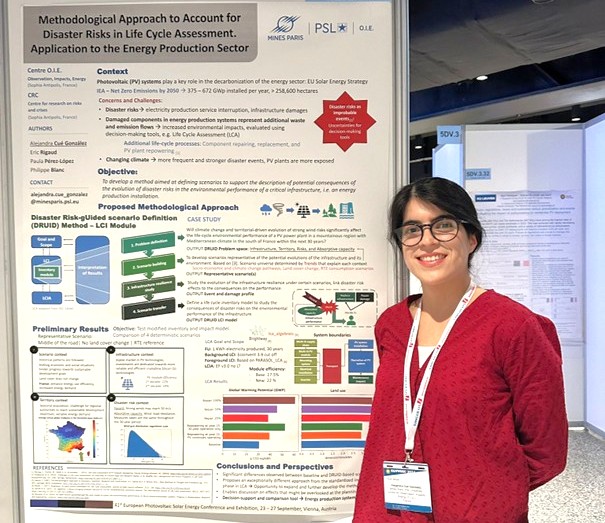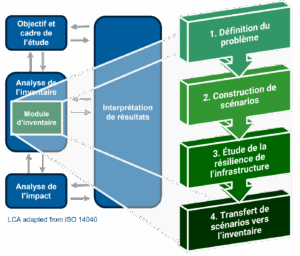Three questions for Alejandra Cue Gonzalez, PhD nominee for her method of assessing the ecological impacts of disasters in the energy sector


On May 21, 2025, at the Hôtel de Roquelaure in Paris, Alejandra was invited to participate in the ministry’s thesis award ceremony. This national prize, created in 2023, recognizes research that contributes to informing and strengthening public policy on ecological transition. It also aims to consolidate links between academia and government by highlighting the excellence of research carried out in particular by higher education institutions specializing in sustainable development.
Alejandra Cue Gonzalez entered the thesis award competition with her work, which proposes an innovative and rigorous approach to the environmental assessment of critical infrastructure in the face of climate hazards and natural disasters.
Entitled “Methodological Approach to Taking Disaster Risks into Account in Life Cycle Analysis: Application to the Energy Production Sector,” her research makes a major contribution to the evolution of Life Cycle Analysis (LCA), a key tool in energy transition planning. It proposes an innovative method called DRUID (Disaster Risk-gUided scenarIo Definition), which makes it possible to better anticipate the environmental impacts of extreme risks, such as a photovoltaic power plant hit by strong winds.

The idea came from a simple observation: in forward-looking environmental analyses based on LCA, systems are generally assessed under so-called “normal” conditions. For example, when estimating the environmental impact of a photovoltaic installation, standard operation without major disruptions is assumed.
But this approach does not reflect reality, especially in the context of climate change. Extreme weather events—storms, floods, fires—are becoming more frequent and intense. These hazards can severely damage infrastructure, prevent it from functioning, or even destroy it entirely. This not only leads to economic losses, but also to additional environmental impacts, which are often underestimated.
That is why we felt it was essential to incorporate these risks into the LCA in order to produce assessments that are more realistic and representative of possible futures. In the context of the energy transition, this not only makes it possible to anticipate vulnerabilities, but also to guide the design of new facilities towards greater resilience to the climate of tomorrow.
The DRUID method aims to combine risk analysis and life cycle assessment (LCA) approaches to provide a more accurate and dynamic view of how environmental impacts evolve throughout the life of an energy system.
The goal is to move beyond average assessments and incorporate the potential effects of extreme events linked to climate change.
By integrating these scenarios from the design phase onwards, decision-makers and engineers can anticipate vulnerabilities and make more informed decisions to strengthen infrastructure resilience.
With this integrated approach, stakeholders in the energy transition are better equipped to design systems that are not only efficient, but also more resilient to future climate uncertainties.
The DRUID method developed during my thesis was fairly exploratory, so these contributions will be even more significant after my postdoctoral project, which aims to develop the method and test it in a real-world case.

Diagram of the DRUID method
As mentioned, I am continuing to work on DRUID as part of my postdoctoral research within the flagship project ELECTRE – Carnot M.I.N.E.S, which focuses on the electrification of uses. The aim is to develop the DRUID method by testing it on a concrete case study, in collaboration with an industrial player in the PV sector in France.
In this work, we will verify the elements of the method that bring real added value in an operational context, as well as those that still need adjustment. Ultimately, the aim is to make the tool more relevant for prospective environmental analysis, with the ambition that it can also feed into strategic thinking in industrial decisions and potentially in public policies related to the energy installations of the future.
Congratulations to Alejandra on her outstanding contribution!
To find out more about the Ministry for Ecological Transition’s 2025 Thesis Prize: